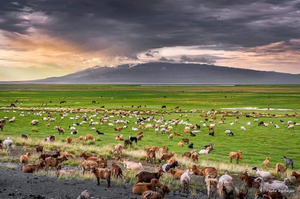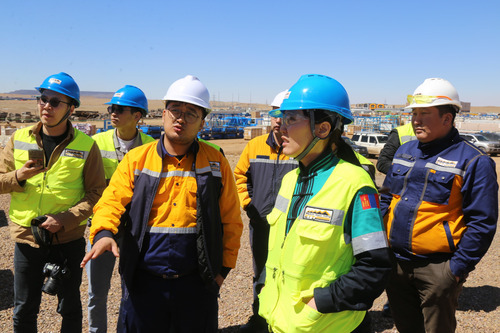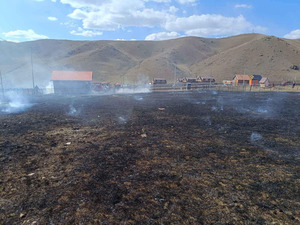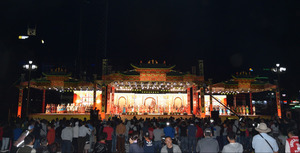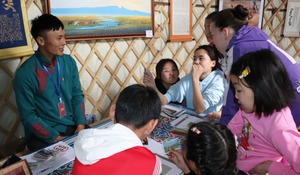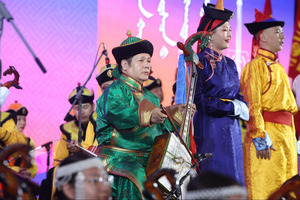Throughout their history, Mongolians passed to younger generations unique traditional nature conservation practices to help them live in harmony with nature and understand its phenomena. This knowledge became a source of the first written environmental laws. 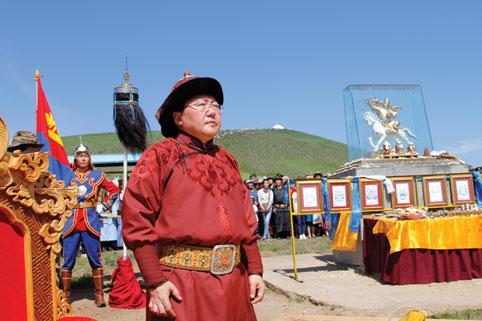
From ancient times, Mongolians worshipped Father-Sky and Mother-Earth. It was a comprehensive recognition of Father-Sky as sky, sun, moon, stars and planets. Mother-Earth was recognized as earth, mountains, water, all animals and plants.
Inherited traditions varied in period, type and character. This indicates that traditional practices weren’t tied to one model. Depending on time, ethnic group and location, practices were different but lead to the main objective to protect natural resources. This is one of the greatest findings of the nomadic lifestyle.
Considering approaches, forms and character of traditional nature conservation practices, they could be divided into 5 main categories: 1/ энэрэл хүндэтгэлийн, 2/ хорио цээрийн prohibition, 3/ mentoring /teaching, doctrinal/, 4/ religious and 5/ observation and cognition. Practices were divided into categories for easy understanding and should not be understood as separate practices.
Compassionate practices are more employed to protect and respect the surrounding environment, mountains, water, animals and plants, leading to the proper use of natural resources to satisfy their own livelihood.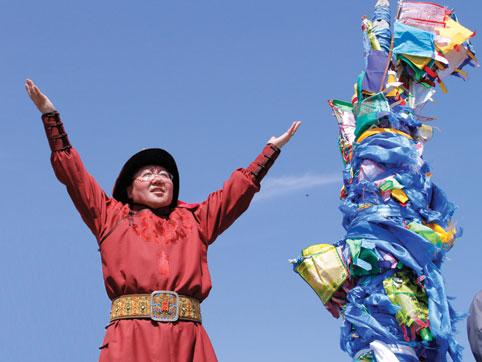
The tradition of Mongolians to wake up early in the morning with the sunrise and sprinkle tea and/or milk, revering nature, appreciating life and praying for peace and love can be seen even in these days. This has played a role in the formation of their behavior to love and respect nature from a young age.
The Mongolian custom to purify the hearth is closely related with worshiping nature and a belief in its power. For example, offering the choicest of meat and dairy to the fire spirit is thought to please the land and bring fortune in life and activities.
The most respectful and largest ceremony of the compassionate practice was to worship a mountain, which is different from worshiping Ovoo’s. It included a large area of land, a place of natural perfection and beauty, which was respected and loved by everyone.
Scientists’ notes in historical documents indicate that mountain worship rituals became a regular event in the 13th century. Burhanhalduun mount in Han Hentii Mountains became a sacred mountain of all Mongols at Chinggis Khan’s period.
The Mongolian First Undurgegeen Zanabazar visited the hot spring of Yeruu and consecrated Burhanhalduun mount worshipped by Chinggis Khan and made it a religious worship mount.
In the Legal Document of Mongolia, Bogd Khan enacted the “Law of Worship Ritual” to worship Hairhan and Otgontenger Mountains on warm pleasant days of summer and fall as well as indicated details on the number of State officials to participate in rituals and the specific procedure and budget for the ritual. For example, meals such as mutton, beef and dairy products for ceremonial preparation of Bogd Khan and Burhanhaldun mountains were prepared by four Halha aimags. Five ministers must participate in Bogd Khan Mountain worship ritual, one deputy minister for Burhanhaldun Mountain and lords from Zasagt Khan and Sain Noyon Khan Aimags had to participate in the worship ritual of Otgontenger Mountain.
The conclusion is that worshiping the mountain was not only a community desire and religious ritual, but an activity organized by the government (State). After the death of Bogd Khan in 1924, communities occasionally did the rituals but they were completely stopped after the 1930’s.
It should also be mentioned that the Ovoo worship ritual is one of the oldest practices of Mongolians. The tradition to put up an Ovoo, a small cairn erected on the mountain to satisfy deities, was one way to love and respect nature that still can be seen nowadays. Depending upon the spirit’s character and the common tradition of local herders of the area, certain incantations were uttered, incenses were put out to purify, choicest of tea, milk and meat were offered and a simple ritual to add a wood stick or rock to the Ovoo took place.
Today Ovoo worship has turned into a ritual where people dump numerous wastes such as the remains of alcohol (bottles), food and other useless trash. This is not an indication of civilization but of the moral degradation that destroys nature conservation traditions.
Even though lamas and shamans played a role in mountain and Ovoo worship rituals, it shouldn’t be considered as a religious ceremony, but it proves that all categories are interrelated. One of the most important parts in the compassionate practice was love and protection of forests and animals. One of the features of the nomadic lifestyle is a tradition to hunt. A compassion for nature was the foundation for a hunting lifestyle. Hunting wasn’t targeted to “get as much as someone can” with greed and a trophy in mind but to get what nature offers and use it properly.
One of the most important parts in the compassionate practice was love and protection of forests and animals. One of the features of the nomadic lifestyle is a tradition to hunt. A compassion for nature was the foundation for a hunting lifestyle. Hunting wasn’t targeted to “get as much as someone can” with greed and a trophy in mind but to get what nature offers and use it properly.
Hunters had a good knowledge of the breeding and strengthening period of animals. Trophies such as meat, skin and fur were used sparingly, appreciating nature’s offerings and having a small ceremonial procedure before hunting in groups. Anyone who breached this tradition was not only considered to be punished by nature but also punished by official law.
Senior hunters’ talks and notes mention that in old times hunters kept in secret the exact day of hunting and communicated with each other with different signs such as exchange of horse dung. During hunting, abusive words and dissension were avoided. Even the name of the hunted animal wasn’t said outright. For example, wolf – dog of the steppe, fox – hat, moose – flat-horn and trophies called “Hangai grace”. It proves that Mongolians loved and respected the Earth and its existing animals and weren’t permitted to use human intellect to destroy it.
Reverence for wood and water plays a role in compassionate practices. Gobi and desert communities revered the saxaul tree, elm and tamarix; while mountain communities revered willow, birch, cedar, and juniper more. Regardless of their location, Mongolians revered the lonely tree and zuun mod (“a hundred trees” - small area covered with trees). It was restricted to break branches or even come close to lonely trees.
Mongolians used willow for ger parts such as uni (pole to make up ger roof), walls and toono, but never cut it along or at the beginning of streams and springs protecting it from drought.
Birch was believed to bring luck and health and use of it has been limited only for ger columns and uurga’s (horse catching pole). Juniper was considered a holy plant and roots were used to make the ladle for airag (mare’s milk) and milk, tsatsal (a flat wooden stick for ritual sprinkling) and currycomb.
Wisdom to protect nature for future generations could be seen in keeping water clean. Strict rules preventing dairy products, blood and dirt from flowing into water sources, regardless of the size of the river or lake, have spread through the entire country.
Protection of mineral springs and keeping the medicinal quality of it is one of the traditional nature conservation practices. In historical notes it has been mentioned that special rituals and rules were established for mineral spring use.
Giving title names for mountains and rivers in honor of their beauty is one of the unique compassionate nature conservation practices. Names and metaphors – Han Tenger (king sky), Hatan Eej (queen mother), the most precious thing in life are used for this purpose. Title names such as Bogd Han, (Bogd King), Hustai Han (Hustai king), Onon hatan eej (queen mother Onon), Hatan Tuul (queen Tuul), Hatan Sevree (queen Sevree), Altan Ovoo (Golden Ovoo) are common. Also the given title was not allowed to be said loudly near these places but preferred as “Undur Hairhan” (Precious Mountain), “Altai Hairhan” or “Dalai Eej” (Mother Lake).
Prohibition nature conservation practices became a method to follow the compassionate practices to restrict certain actions to protect nature.
First of all, in spring and summer, during the regeneration period of all livings things, Mongolians are forbidden to dig holes, cut trees and bushes (especially at the beginning of springs), or to collect onions, plants and fruits in large amounts. As birds are considered sky creatures, killing or damaging nests and eggs was restricted. Revering sky creatures was tightly connected to a myth of Father-Sky.
Places and mountains of natural perfection and beauty were called “Dogshin Hairhan” (brutal mountain) with a prohibition not to cut trees, collect plants and fruits and hunt. If the rules were breached, Mongolians had a strong belief that spirits would get fiercer and call bad luck, unhappiness and illness upon the person and his family.
A role in prohibition practice placed a restriction to not pollute water. It was thought that pouring milk and other dairy products into water kills non-mammal animals. Also it was highly prohibited to litter near water sources, nearby ravines and to wash dirty things in the water.
It has been thought that a sin was killing animals during breeding season, animals with offspring or wet-nursed animals, a lead of a herd, or when the public hunting period was closed.
Some of these prohibition traditions later became a source for ancient and even today’s written laws.
Doctrinal method of nature conservation was more targeted to understanding natural phenomena, to love and respect nature, and to pass on the knowledge of proper use of natural resources.
Mongolians considered that earth is a living creature just as humans are. Before digging a hole for a hitching post, digging wells and ploughing, Mongolians had a ritual to utter a benediction and make offerings for spirits. When they moved to another site, all trash was picked up and holes were filled with earth.
Cutting down a live tree was considered a sin. Live trees cry with milk, so the family will suffer from a shortage of dairy products. To avoid forest fires, the fire was built on a rocky surface and when the fire was put out, to prove its safety, dry grass was put on top of it. The main tools to pass knowledge for future generations were traditional games and oral literature as tales, stories, legends and songs.
Religious nature conservation practice could be considered as a belief in a supernatural force. Mountains, rivers, lakes, animals and birds are thought to have a master that looks after them.
Buddhism also played a role in forming the nature conservation sense. In religious doctrines it was mentioned that a man and his family would suffer from bad luck if he hunted, killed animals, cut a tree, picked up rocks or plants, or littered in sacred areas.
Entrusting of fate, health and well being by prayers and offerings to spirits of mountain and water is another important part of religious nature conservation practices. For example, Ulaanbaatar citizens pray to Bogd Han, Songino Hairhan, Chingeltei, Bayanzurh Mountains (four surrounding mountains of UB); Sukhbaatar aimag residents to Altan Ovoo; Zuunhangai and Undurhangai soum (provincial unit) residents of Uvs aimag to Han Huhii.
Observation and cognition practices are used more to predict weather or disasters by everyday observation of domestic and wild animal behaviors and changes in household items. This is one of important thing for nomadic life.
Animal behavior, position of the moon and stars, and changes in the body and organs of the elderly were carefully observed. It is not a one day event but a long term observation. Predicting weather is essential for a nomadic lifestyle when welfare depends on domestic animals.
Below are examples of how Mongolians predicted the next day or season:
• If yaks graze high in the mountains and horses in mountain foot it is a sign that the next day will be nice and warm.
• If cattle do not graze and camels prefer to lie during the daytime it is a sign that cold days are coming.
• Whining of dogs and cats and bleating and mooing of domestic animals for several days are signs of a coming earthquake or flood.
• If soot on the bottom of cooking-pot gets reddish color it is a sign of warm days coming. If salt is moist, sign of rain coming.
Prediction of the weather is still important to choose the right time to move to new pasture or to winter and summer houses as well as to get good hay for the animals.
The following are concluded from the traditional and historical issue of environmental protection:
1. Mongolians had a unique tradition for nature conservation and an environmentally friendly lifestyle. Every Mongolian had an object of worship that could be considered as a Mother Nature. All above mentioned should be recognized not only in national but in international status.
2. Mongolian nature conservation practices are not just traditions, but a comprehensive understanding of nature as an everlasting source of life and spirit, nature-centered life and source of aesthetics, knowledge and cognition. These were the main sources to form a nature-loving character.
3. The nomadic tradition of nature conservation is a valuable source of knowledge that social science should do a detailed research of. Unfortunately, transition of the lifestyle from nomadic to urban removes these valuable traditions and today people are behaving more cruelly and harshly to nature.
4. Restoration of nature conservation traditions is not only beneficial for protecting natural resources but also plays a role in strengthening relationships between old and young generations.
5. Mongolian nature conservation tradition could be a foundation of sustainable development, a gateway for an environmentally friendly existence. There is a tendency of gradual reduction of nature conservation traditions that has to be stopped immediately.



